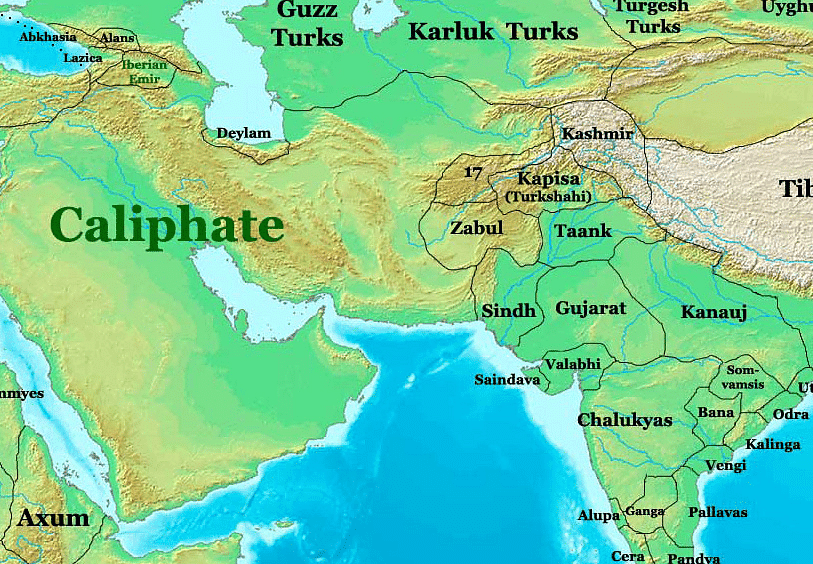Spectrum Summary: Expansion & Consolidation of British Power in India- 2 | History for UPSC CSE PDF Download
ANGLO-MARATHA STRUGGLE FOR SUPREMACY
Rise of the Marathas
- Bajirao I (1720-40), considered greatest of all the Peshwas, had started a confederacy of rapidly expanding Maratha power, and to some extent appeased the Kshatriya section of the Marathas (Peshwas were brahmins) led by the Senapati Dabodi.
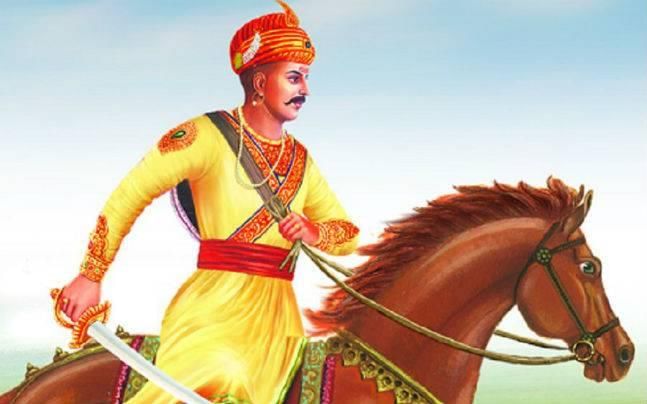 Bajirao I
Bajirao I - The Maratha families which emerged prominently were—
(a) The Gaekwad of Baroda
(b) The Bhonsle of Nagpur
(c) The Holkars of Indore
(d) The Sindhias of Gwalior and
(e) The Peshwa of Poona - The defeat at Panipat and later the death of the young Peshwa, Madhavrao I, in 1772, weakened the control of the Peshwas over the confederacy.
The Entry of the English into Maratha Politics
The English in Bombay wanted to establish a government along the lines of the arrangement made by Clive in Bengal, Bihar and Orissa.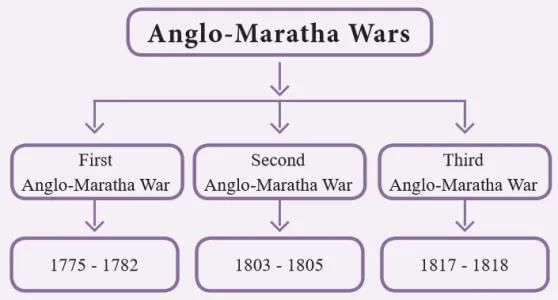
➢ First Anglo-Maratha War (1775-82)
- After the death of Madhavrao in 1772, his brother Narayanrao succeeded him as the fifth Peshwa.
- Treaties of Surat and Purandhar Raghunathrao, unwilling to give up his position in power, sought help from the English at Bombay and signed the Treaty of Surat in 1775.
- Under the treaty, Raghunathrao ceded the territories of Salsette and Bassein to the English along with a portion of the revenues from the Surat and Bharuch districts. In return, the English were to provide Raghunathrao with 2,500 soldiers.
- The British Calcutta Council condemned the Treaty of Surat (1775) and sent Colonel Upton to Pune to annul it and make a new treaty (Treaty of Purandhar, 1776) with the regency renouncing Raghunath and promising him a pension. The Bombay government rejected this and gave refuge to Raghunath.
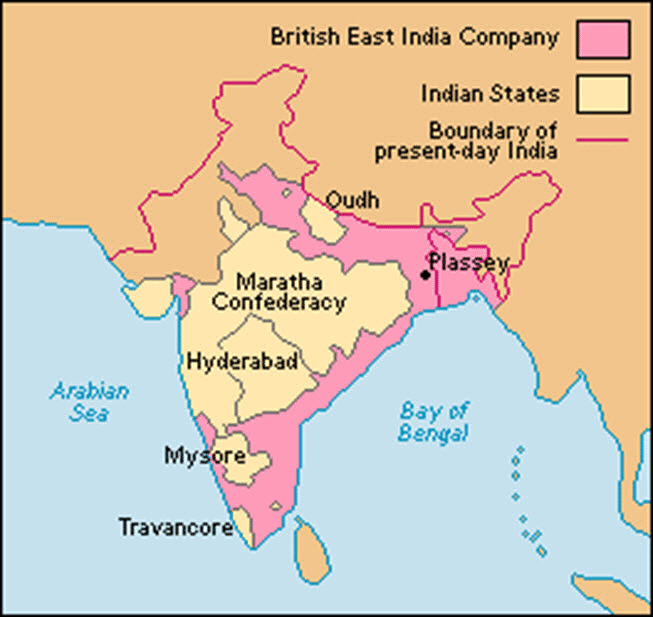
- In 1777, Nana Phadnavis violated his treaty with the Calcutta Council by granting the French a port on the west coast.
- Mahadji lured the English army into the ghats (mountain passes) near Talegaon trapped the English from all sides and attacked the English supply base at Khopali. The Marathas also utilised a scorched earth policy, burning farmland and poisoning wells.
- The English surrendered by mid-January 1779 and signed the Treaty of Wadgaon that forced the Bombay government to relinquish all territories acquired by the English since 1775.
- Treaty of Salbai (1782): End of the first phase of the struggle Warren Hastings, the Governor-General in Bengal, rejected the Treaty of Wadgaon and under Colonel Goddard who captured Ahmedabad in February 1779, and Bassein in December 1780.
- Another Bengal detachment led by Captain Popham captured Gwalior in August 1780. In February 1781 the English, under General Camac, finally defeated Sindhia at Sipri.
- Sindhia proposed a new treaty between the Peshwa and the English, and the Treaty of Salbai was signed in May 1782, it was ratified by Hastings in June 1782 and by Phadnavis in February 1783.
- The treaty guaranteed peace between the two sides for twenty years.
- The main provisions of the Treaty of Salbai were:
(i) Salsette should continue in the possession of the English.
(ii) The whole of the territory conquered since the Treaty of Purandhar (1776) including Bassein should be restored to the Marathas.
(iii) In Gujarat, Fateh Singh Gaekwad should remain in possession of the territory that he had before the war and should serve the Peshwa as before.
(iv) The English should not offer any further support to Raghunathrao and the Peshwa should grant him a maintenance allowance.
(v) Haidar Ali should return all the territory taken from the English and the Nawab of Arcot.
(vi) The English should enjoy the privileges of trade as before.
(vii) The Peshwa should not support any other European nation.
(viii) The Peshwa and the English should undertake that their several allies should remain at peace with one another.
(ix) Mahadji Sindhia should be the mutual guarantor for the proper observance of the terms of the treaty.Question for Spectrum Summary: Expansion & Consolidation of British Power in India- 2Try yourself:Which peshwa was considered the more prominent one in Maratha history?View Solution
➢ Second Anglo-Maratha War (1803-1805)
- The death of Nana Phadnavis in 1800 gave the British an added advantage.
On October 25, 1802, Jaswant defeated the armies of the Peshwa and Sindhia decisively at Hadaspar near Poona and placed Vinayakrao, son of Amritrao, on the Peshwa’s seat. - A terrified Bajirao II fled to Bassein on December 31, 1802.
- Treaty of Bassein (1802) Under the treaty, the Peshwa agreed:
(a) To receive from the Company a native infantry (consisting of not less than 6,000 troops), with the usual proportion of field artillery and European artillerymen attached, to be permanently stationed in his territories.
(b) To cede to the Company territories yielding an income of Rs 26 lakh.
(c) To surrender the city of Surat.
(d) To give up all claims for Chauth on the Nizam's dominions.
(e) To accept the Company’s arbitration in all differences between him and the Nizam or the Gaekwad.
(f) Not to keep in his employment Europeans of any nation at war with the English and
(g) To subject his relations with other states to the control of the English.
(h) Defeat of Bhonsle (December 17, 1803, Treaty of Devgaon), the defeat of Sindhia (December 30, 1803, Treaty of Surajianjangaon) and the defeat of Holkar (1806, Treaty of Rajpurghat).
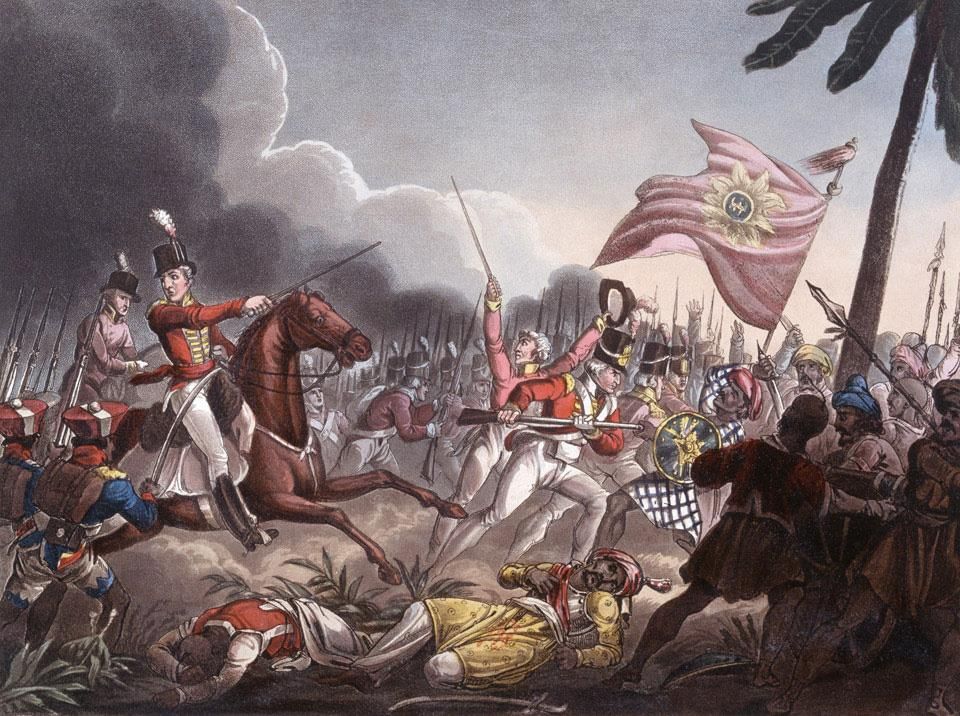 Second Anglo-Maratha War
Second Anglo-Maratha War- Treaty was signed by a Peshwa who lacked political authority, but the gains made by the English were immense.
- The treaty "gave the English the key to India”.
➢ Third Anglo-Maratha War (1817-19)
- By the Charter Act of 1813, the East India Company’s monopoly of trade in China (except tea) ended.
- Bajirao II made the last bid in 1817 by rallying together the Maratha chiefs against the English in the course of the Third Anglo-Maratha War.
- The Peshwa attacked the British Residency at Poona. Appa Sahib of Nagpur attacked the residency at Nagpur.
- The Peshwa was defeated at Khirki, Bhonsle at Sitabuldi, and Holkar at Mahidpur.
- Important treaties were signed. These were:
(i) June 1817, Treaty of Poona, with Peshwa.
(ii) November 1817, Treaty of Gwalior, with Sindhia.
(iii) January 1818, Treaty of Mandasor, with Holkar. In June 1818. - The Peshwa finally surrendered and the Maratha confederacy was dissolved. The Peshwaship was abolished. Peshwa Bajirao became a British retainer at Bithur near Kanpur.
- Pratap Singh was made ruler of Satara, formed out of the Peshwa's dominions.
Why did the Marathas lose?
- Inept Leadership later Maratha leaders Bajirao II, Daulatrao Sindhia and Jaswantrao Holkar were worthless and selfish leaders.
- Defective Nature of Maratha State - The cohesion of the people of the Maratha state was not organic but artificial and accidental, and hence precarious.
- Loose Political Set-up lack of a cooperative spirit among the Maratha chiefs proved detrimental to the Maratha state.
- Inferior Military System- Though full of personal prowess and valour, the Marathas were inferior to the English in the organisation of the forces, in war weapons, in disciplined action and ineffective leadership.
- Unstable Economic Policy- The Maratha leadership failed to evolve a stable economic policy
- Superior English Diplomacy and Espionage- The English had the better diplomatic skill to win allies and isolate the enemy.
- Progressive English Outlook- The English were rejuvenated by the forces of Renaissance The English attacked a 'divided house' which started crumbling after a few pushes.
The Conquest of Sindh
Rise of Talpuras Amirs
- Before the rule of Talpuras Amirs, Sindh was ruled by the Kallora chiefs.
- In 1758, an English factory was built at Thatta, owing to a Parwana given by the Kallora prince, Ghulam Shah. In 1761, Ghulam Shah, on the arrival of an English resident in his court, not only ratified the earlier treaty but also excluded other Europeans from trading there.
- This advantage was enjoyed by the English up to 1775
- In the 1770s, a Baluch tribe called Talpuras descended from the hills and settled in the plains of Sindh.
- In 1783, the Talpuras, under the leadership of Mir Fath (Fatah) Ali Khan, established a complete hold over Sindh.
- They conquered Amarkot from the Raja of Jodhpur, Karachi from the chief of Luz, Shaikarpur and Bukkar from the Afghans. Question for Spectrum Summary: Expansion & Consolidation of British Power in India- 2Try yourself:With respect to Anglo Maratha wars, consider the following reasons;
1. Defective nature of Maratha
2. Stable economic policy
3. Inferior Military
Which of the above given is/are correct?View Solution
Gradual Ascendancy over Sindh
- Under the influence of Tipu Sultan and the jealousy of the local traders, aided by the anti-British party at Hyderabad (Sindh), the amir in October 1800, ordered the British agent to quit Sindh within ten days.
- Treaty of ‘Eternal Friendship’
(i) Metcalfe was sent to Lahore, Elphinstone to Kabul and Malcolm to Teheran.
(ii) After professing eternal friendship, both sides agreed to exclude the French from Sindh and to exchange agents at each other's court.
(iii) The treaty was renewed in 1820 with the addition of an article excluding the Americans and resolving some border disputes on the side of Kachch after the final defeat of the Maratha confederacy in 1818. - Treaty of 1832- In 1832, William Bentinck sent Colonel Pottinger to Sindh to sign a treaty with the Amirs.
The provisions of the treaty were as follows:
(i) Free passage through Sindh would be allowed to the English traders and travellers and the use of the Indus for trading purposes, however, no warships would ply, nor any war materials would be carried.
(ii) No English merchant would settle down in Sindh, and passports would be needed for travellers.
(iii) Tariff rates could be altered by the Amirs if found high and no military dues or tolls would be demanded.
(iv) The Amirs would work with the Raja of Jodhpur to put down the robbers of Kutch. - Lord Auckland and Sindh - Lord Auckland, who became the Governor-General in 1836.
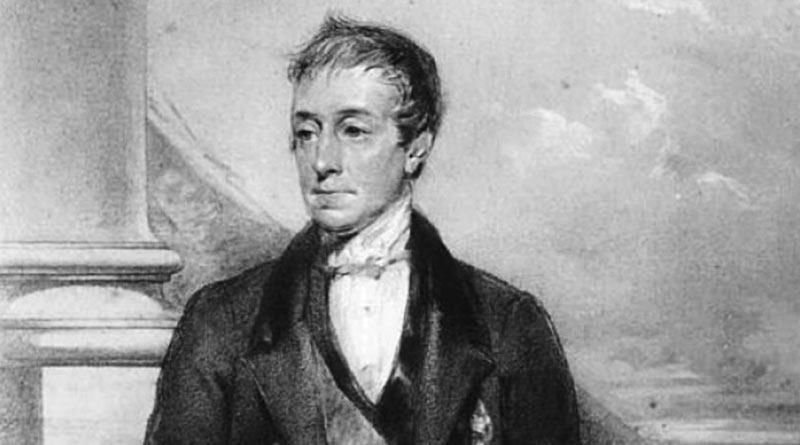 Lord Auckland
Lord Auckland - Tripartite Treaty of 1838 - The Company persuaded Ranjit Singh to sign a tripartite treaty in June 1838 agreeing to British mediation in his disputes with the Amirs, and then made Emperor Shah Shuja give up his sovereign rights on Sindh, provided the arrears of tribute were paid.
- Sindh Accepts Subsidiary Alliance (1839) - B. L. Grover writes: “Under threat of superior force, the Amirs accepted a treaty in February 1839 by which a British subsidiary force had to be stationed at Shikarpur and Bukkar and the Amirs of Sindh were to pay Rs. 3 lakh annually for the maintenance of the Company’s troops”.
- The capitulation of Sindh -The First Anglo-Afghan War (1839-42), fought on the soil of Sindh. The whole of Sindh capitulated within a short time, and the Amirs were made captives and banished from Sindh. In 1843, under Governor-General Ellenborough, Sindh was merged into the British Empire and Charles Napier was appointed its first governor.
Criticisms of the Conquest of Sindh
- In the instance of the First Afghan War, the English suffered terribly at the hands of the Afghans with a corresponding loss of prestige.
- To compensate for this, they annexed Sindh which prompted Elphinstone to comment: “Coming from Afghanistan it put one in mind of a bully who has been knocked in the street and went home to beat his wife in revenge.” Question for Spectrum Summary: Expansion & Consolidation of British Power in India- 2Try yourself:Who signed the treaty with the Amirs?View Solution
Conquest of Punjab
➢ Consolidation of Punjab under the Sikhs
- In 1715, Banda Bahadur was defeated by Farrukhsiyar and put to death in 1716. Thus the Sikh polity, once again, became leaderless and later got divided into two groups— Bandai (liberal) and Tat Khalsa (Orthodox).
- In 1784 Kapur Singh Faizullapuria organised the Sikhs under Dal Khalsa, to unite followers of Sikhism, politically, culturally and economically.
- The whole body of the Khalsa was formed into two sections— Budha Dal, the army of the veterans, and Taruna Dal, the army of the young. The Sikhs consolidated in mislsMisl is an Arabic word which means equal or alike. Another meaning of Misl is State.
➢ Sukarchakiya Misl and Ranjit Singh
- At the time of the birth of Ranjit Singh (November 2, 1780), there were 12 important misls:
Ahluwaliya, Bhangi, Dallewalia, Faizullapuria, Kanhaiya, Krorasinghia, Nakkai, Nishaniya, Phulakiya, Ramgarhiya Sukharchakiya, and Shaheed.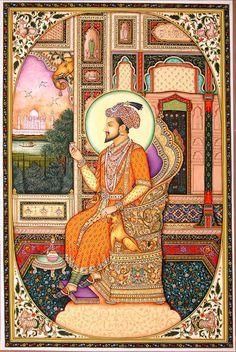 Ranjit Singh
Ranjit Singh - The central administration of a misl was based on Gurumatta Sangh.
- In 1799, Ranjit Singh was appointed as the governor of Lahore by Zaman Shah, the ruler of Afghanistan.
- In 1805, Ranjit Singh acquired Jammu and Amritsar and thus the political capital (Lahore) and religious capital (Amritsar) of Punjab came under the rule of Ranjit Singh.
➢ Ranjit Singh and the English
The Napoleonic danger receded and the English became more assertive, Ranjit Singh agreed to sign the Treaty of Amritsar (April 25, 1809) with the Company.
Treaty of Amritsar
- It checked one of the most cherished ambitions of Ranjit Singh to extend his rule over the entire Sikh nation by accepting the river Sutlej as the boundary line for his dominions and the Company.
- Now he directed his energies towards the west and captured Multan (1818), Kashmir (1819) and Peshawar (1834). In June 1838, Ranjit Singh was compelled by political compulsions to sign the Tripartite Treaty with the English.
➢ Punjab After Ranjit Singh
- Beginning of Court Factions - Discontent was growing among the troops as a result of irregularity of payment. The appointment of unworthy officers led to indiscipline. These marches resulted in the commotion and economic dislocation in Punjab.
- Rani Jindal and Daleep Singh - Daleep Singh, a minor son of Ranjit Singh, was proclaimed the Maharaja with Rani Jindan as regent and Hira Singh Dogra as wazir.
➢ First Anglo-Sikh War (1845-46)
- The causes were as follows:
(i) The anarchy in the Lahore kingdom following the death of Maharaja Ranjit Singh resulting in a power struggle for domination between the court at Lahore and the ever-powerful and increasingly local army.
(ii) Suspicions amongst the Sikh army arose from English military campaigns to achieve the annexation of Gwalior and Sindh in 1841 and the campaign in Afghanistan in 1842.
(iii) The increase in the number of English troops stationed near the Lahore kingdom's border. - The war began in December 1845 with 20,000 to 30,000 troops in the British side, while the Sikhs had about 50,000 men.
- The treachery of Lai Singh and Teja Singh caused five successive defeats to the Sikhs at Mudki (December 18, 1845), Ferozeshah (December 21-22, 1845), Buddelwal, Aliwal (January 28, 1846), and at Sobraon (February 10, 1846). Lahore fell to the British forces on February 20, 1846, without a fight.
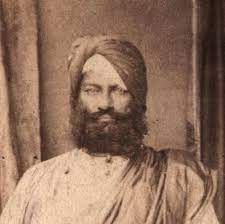
- Treaty of Lahore (March 8, 1846) - The end of the First Anglo-Sikh War forced the Sikhs to sign a humiliating treaty on March 8, 1846.
The main features of the Treaty of Lahore were as follows:
(i) War indemnity of more than 1 crore rupees was to be given to the English.
(ii) The Jalandhar Doab (between the Beas and the Sutlej) was annexed to the Company’s dominions.
(iii) A British resident was to be established at Lahore under Henry Lawrence.
(iv) The strength of the Sikh army was reduced.
(v) Daleep Singh was recognised as the ruler under Rani Jindan as regent and Lai Singh as wazir.
(vi) Since, the Sikhs were not able to pay the entire war indemnity, Kashmir including Jammu was sold to Gulab Singh and he was required to pay Rupees 75 lakh to the Company as the price.
(vii) The transfer of Kashmir to Gulab Singh was formalised by a separate treaty on March 16, 1846. - Treaty of Bhairowal - The Sikhs were not satisfied with the Treaty of Lahore over the issue of Kashmir, so they rebelled. In December 1846, the Treaty of Bhairowal was signed. According to the provisions of this treaty, Rani Jindan was removed as regent and a council of regency for Punjab was set up. The council consisted of 8 Sikh sardars presided over by the English Resident, Henry Lawrence.
➢ Second Anglo-Sikh War (1848-49)
- Sher Singh was sent to suppress the revolt, but he joined Mulraj, leading to a mass uprising in Multan. This could be considered as the immediate cause of the war.
- Three important battles were fought before the final annexation of Punjab.
These three battles were:
(i) Battle of Ramnagar, led by Sir Hugh Gough, the commander-in-chief of the Company.
(ii) Battle of Chillhanwala, January 1849.
(iii) Battle of Gujarat, February 21, 1849, the Sikh army surrendered at Rawalpindi, and their Afghan allies were chased out of India. - At the end of the war came:
(i) Surrender of the Sikh army and Sher Singh in 1849;
(ii) Annexation of Punjab, and for his services the Earl of Dalhousie was given the thanks of the British Parliament and promotion in the peerage, as Marquess.
(iii) Setting up of a three-member board to govern Punjab, comprising of the Lawrence brothers (Henry and John) and Charles Mansel. - In 1853 John Lawrence became the first chief commissioner.
- Significance of the Anglo-Sikh Wars -The Anglo-Sikh wars gave the two sides a mutual respect's fighting prowess.
Extension of British Paramountcy through Administrative Policy
The process of imperial expansion and consolidation of British paramountcy was carried on by the Company during the 1757-1857 period through a two-fold method:
(a) Policy of annexation by conquest or war and
(b) Policy of annexation by diplomacy and administrative mechanisms.

➢ The Policy of Ring-Fence
- Warren Hastings followed a policy of ring-fence which aimed at creating buffer zones to defend the Company’s frontiers.
- This policy of Warren Hastings was reflected in his war against the Marathas and Mysore.
- The states brought under the ring-fence system were assured of military assistance against external aggression—but at their own expense.
- Wellesley’s policy of subsidiary alliance was, in fact, an extension of the ring-fence system which sought to reduce the Indian states into a position of dependence on the British government.
➢ Subsidiary Alliance
- The subsidiary alliance system was used by Lord Wellesley, who was governor-general from 1798-1805.
- Under the system, the allying Indian state’s ruler was compelled to accept the permanent stationing of a British force within his territory and to pay a subsidy for its maintenance.
- The Indian ruler had to agree to the posting of a British resident in his court. Under the system, the Indian ruler could not employ any European in his service without the prior approval of the British.
- Nor could he negotiate with any other Indian ruler without consulting the governor-general. In return for all this, the British would defend the ruler from his enemies and adopt a policy of non-interference in the internal matters of the allied state.
- Evolution and Perfection - It was probably Dupleix, who first gave on hire (so to say) European troops to Indian rulers to fight their wars.
- The first Indian state to fall into this protection trap (which anticipated the subsidiary alliance system) was Awadh which in 1765 signed a treaty under which the Company pledged to defend the frontiers of Awadh.
- It was in 1787 that the Company insisted that the subsidiary state should not have foreign relations. This was included in the treaty with the Nawab of Carnatic which Cornwallis signed in February 1787. Question for Spectrum Summary: Expansion & Consolidation of British Power in India- 2Try yourself:Who was the governor general of India when Sindh was merged into the British empire?View Solution
Stages of Application of Subsidiary Alliance
(i) The first stage, the Company offered to help a friendly Indian state with its troops to fight any war the state might be engaged in.
(ii) The second stage consisted of making a common cause with the Indian state now made friendly and taking the field with its soldiers and those of the state.
(iii) The third stage when the Indian ally was asked not for men but money. The Company promised that it would recruit, train, and maintain a fixed number of soldiers under British officers and that the contingent would be available to the ruler for his personal and family's protection as also for keeping out aggressors, all for a fixed sum of money.
(iv) In the fourth or the last stage, the money or the protection fee was fixed, usually at a high level; when the state failed to pay the money in time, it was asked to cede certain parts of its territories to the Company in place of payment.
States which Accepted Alliance The Indian princes who accepted the subsidiary system were:
(i) The Nizam of Hyderabad (September 1798 and 1800)
(ii) The ruler of Mysore (1799), The ruler of Tanjore (October 1799)
(iii) The Nawab of Awadh (November 1801)
(iv) The Peshwa (December 1801)
(v) The Bhonsle Raja of Berar (December 1803)
(vi) The Sindhia (February 1804)
(vii) The Rajput states of Jodhpur Jaipur, Macheri, Bundi and the ruler of Bharatpur (1818)
(viii) The Holkars were the last Maratha confederation to accept the Subsidiary Alliance in 1818.
➢ Doctrine of Lapse
- In simple terms, the doctrine stated that the adopted son could be the heir to his foster father's private property, but not the state; it was for the paramount power (the British) to decide whether to bestow the state on the adopted son or to annex it.
- Though this policy is attributed to Lord Dalhousie (1848-56), he was not its originator.
- Seven states were annexed under the Doctrine of Lapse: Satara (1848), Jhansi and Nagpur (1854). The other small states included Jaitpur (Bundelkhand), Sambalpur (Orissa), and Baghat (Madhya Pradesh).
- Lord Dalhousie annexed Awadh in 1856.
RELATIONS OF BRITISH INDIA WITH NEIGHBOURING COUNTRIES
➢ Anglo-Bhutanese Relations
- In 1865, the Bhutanese were forced to surrender the passes in return for an annual subsidy.
- It was the surrendered district which became a productive area with tea gardens.
➢ Anglo-Nepalese Relations
- In 1801, the English annexed Gorakhpur which brought the Gorkhas boundary and the Company’s boundary together.
- The conflict started due to the Gorkhas capture of Butwal and Sheoraj in the period of Lord Hastings (1813-23).
- The war ended in the Treaty of Sagauli,1816 which was in favour of the British.
As per the treaty:
(i) Nepal accepted a British resident.
(ii) Nepal ceded the districts of Garhwal and Kumaon and abandoned claims to Terai.
(iii) Nepal also withdrew from Sikkim. - This agreement brought many advantages to the British:
(i) The British empire now reached the Himalayas.
(ii) It got better facilities for trade with Central Asia.
(iii) It acquired sites for hill stations, such as Shimla, Mussoorie and Nainital and
(iv) The Gorkhas joined the British Indian Army in large numbers.
➢ Anglo-Burmese Relations
- The expansionist urges of the British, fuelled by the lure of the forest resources of Burma, market for British manufactures in Burma.
- First Burma War (1824-26)- The first war with Burma was fought when the Burmese expansion westwards and occupation of Arakan and Manipur, and the threat to Assam and the Brahmaputra Valley. The British expeditionary forces occupied Rangoon in May 1824 and reached within 72 km of the capital at Ava. Peace was established in 1826 with the Treaty of Yandabo which provided that the Government of Burma.
(i) Pay rupees one crore as war compensation.
(ii) Cede its coastal provinces of Arakan and Tenasserim.
(iii) Abandon claims on Assam, Cachar and Jaintia.
(iv) Recognise Manipur as an independent state, negotiate a commercial treaty with Britain and
(v) Accept a British resident at Ava, while posting a Burmese envoy at Calcutta. - Second Burma War (1852)- The second war was the result of the British commercial need and the imperialist policy of Lord Dalhousie. The British merchants were keen to get hold of timber resources of upper Burma and also sought further inroads into the Burmese market.
- Third Burma War (1885)- A humiliating fine had been imposed on a British timber company by Thibaw. Duffer in ordered the invasion and final annexation of upper Burma in 1885.
➢ Anglo -Tibetan Relations
- Tibet was ruled by a theocracy of Buddhist monks (lamas) under the nominal suzerainty of China.
- Treaty of Lhasa (1904) Younghusband dictated terms to the Tibetan officials which provided that:
(i) Tibet would pay an indemnity of Rs 75 lakh at the rate of one lakh rupees per annum.
(ii) As security for payment, the Indian Government would occupy the Chumbi Valley (territory between Bhutan and Sikkim) for 75 years.
(iii) Tibet would respect the frontier of Sikkim.
(iv) Trade marts would be opened at Yatung, Gyantse, Gartok and
(v) Tibet would not grant any concession for railways, roads, telegraph, etc., to any foreign state, but give Great Britain some control over foreign affairs of Tibet.
(vi) The treaty was revised reducing the indemnity from Rs 75 lakh to Rs 25 lakh and providing for evacuation of Chumbi valley after three years. - Significance - Only China gained in the end out of the whole affair because of the Anglo- Russian convention of 1907.
➢ Anglo-Afghan Relations
- Treaty of Turkomanchai (1828), Passes of the north-west seemed to hold the key to enter India. The need was felt for Afghanistan to be under the control of a ruler friendly to the British.
- Forward Policy of Auckland, Auckland who came to India as the governor-general in 1836, advocated a forward policy. This implied that the Company government in India itself had to take initiatives to protect the boundary of British India.
- A Tripartite Treaty (1838) was entered into by the British, Sikhs and Shah Shuja The treaty provided that—
(i) Shah Shuja is enthroned with the armed help of the Sikhs, the Company remaining in the background, "jingling the money-bag'.
(ii) Shah Shuja conduct foreign affairs with the advice of the Sikhs and the British.
(iii) Shah Shuja give up his sovereign rights over Amirs of Sindh in return for a large sum of money.
(iv) Shah Shuja recognise the Sikh ruler, Maharaja Ranjit Singh's claims over the Afghan territories on the right bank of the River Indus.
First Anglo-Afghan War (1839-1842)
- The British decided to go ahead with their forward policy. This resulted in the First Afghan War (1839 -The British intention was to establish a permanent barrier against schemes of aggression from the north-west. The British were compelled to sign a treaty (1841) with the Afghan chiefs by which they agreed to evacuate Afghanistan and restore Dost Mohammed. The First Afghan War cost India one-and-a-half crore rupees and nearly 20,000 men.
John Lawrence and the Policy of Masterly Inactivity
Lawrence’s policy rested on the fulfilment of two conditions I. that the peace at the frontier was not disturbed and II. that no candidate in civil war sought foreign help.
Lytton and the Policy of Proud Reserve
Lytton, a nominee of the Conservative government under Benjamin Disraeli (1874-80), became the Viceroy of India in 1876. He started a new foreign policy of 'proud reserve', which was aimed at having scientific frontiers and safeguarding spheres of influence.
Second Anglo-Afghan War (1870-80)
Sher Ali fled in face of the British invasion, and the treaty of Gandamak (May 1879) was signed with Yakub Khan, the eldest son of Sher Ali. Treaty of Gandamak (May 1879) the treaty signed after the Second-Anglo Afghan War provided that:
(i) The Amir conduct his foreign policy with the advice of the Government of India.
(ii) A permanent British resident be stationed at Kabul and
(iii) The Government of India give Amir all support against foreign aggression and an annual subsidy.
British India and the North-West Frontier
- A compromise was finally reached by drawing a boundary line known as the Durand Line between Afghan and British territories.
- Curzon, the viceroy between 1899 and 1905, followed a policy of withdrawal and concentration.
- He created the North-West Frontier Province (NWFP) directly under the Government of India.
- In January 1932, it was announced that the NWFP was to be constituted as a governor’s province. Since 1947, the province belongs to Pakistan.
This document is just a brief about the expansion of British power in our country. In the upcoming documents these topics will be dealt in detail. In the next EduRev document you will read about the revolts that happened all over the country which created sparks for the first war of Independence in 1857.
|
109 videos|653 docs|168 tests
|
FAQs on Spectrum Summary: Expansion & Consolidation of British Power in India- 2 - History for UPSC CSE
| 1. What was the Anglo-Maratha struggle for supremacy? |  |
| 2. How did the Marathas rise to power? |  |
| 3. What were the main reasons for the Marathas' loss in the Anglo-Maratha wars? |  |
| 4. What were the criticisms of the conquest of Sindh by the British? |  |
| 5. What was the significance of the conquest of Punjab by the British? |  |


